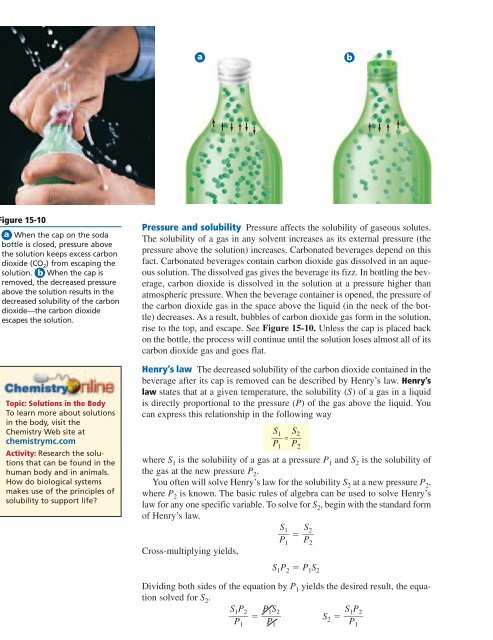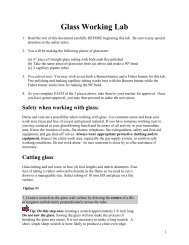Chapter 15: Solutions - Weironline.net
Chapter 15: Solutions - Weironline.net
Chapter 15: Solutions - Weironline.net
Create successful ePaper yourself
Turn your PDF publications into a flip-book with our unique Google optimized e-Paper software.
Figure <strong>15</strong>-10<br />
a When the cap on the soda<br />
bottle is closed, pressure above<br />
the solution keeps excess carbon<br />
dioxide (CO2 ) from escaping the<br />
solution. b When the cap is<br />
removed, the decreased pressure<br />
above the solution results in the<br />
decreased solubility of the carbon<br />
dioxide—the carbon dioxide<br />
escapes the solution.<br />
Topic: <strong>Solutions</strong> in the Body<br />
To learn more about solutions<br />
in the body, visit the<br />
Chemistry Web site at<br />
chemistrymc.com<br />
Activity: Research the solutions<br />
that can be found in the<br />
human body and in animals.<br />
How do biological systems<br />
makes use of the principles of<br />
solubility to support life?<br />
460 <strong>Chapter</strong> <strong>15</strong> <strong>Solutions</strong><br />
Pressure and solubility Pressure affects the solubility of gaseous solutes.<br />
The solubility of a gas in any solvent increases as its external pressure (the<br />
pressure above the solution) increases. Carbonated beverages depend on this<br />
fact. Carbonated beverages contain carbon dioxide gas dissolved in an aqueous<br />
solution. The dissolved gas gives the beverage its fizz. In bottling the beverage,<br />
carbon dioxide is dissolved in the solution at a pressure higher than<br />
atmospheric pressure. When the beverage container is opened, the pressure of<br />
the carbon dioxide gas in the space above the liquid (in the neck of the bottle)<br />
decreases. As a result, bubbles of carbon dioxide gas form in the solution,<br />
rise to the top, and escape. See Figure <strong>15</strong>-10. Unless the cap is placed back<br />
on the bottle, the process will continue until the solution loses almost all of its<br />
carbon dioxide gas and goes flat.<br />
Henry’s law The decreased solubility of the carbon dioxide contained in the<br />
beverage after its cap is removed can be described by Henry’s law. Henry’s<br />
law states that at a given temperature, the solubility (S) of a gas in a liquid<br />
is directly proportional to the pressure (P) of the gas above the liquid. You<br />
can express this relationship in the following way<br />
S 1<br />
����� P1<br />
P2<br />
where S1 is the solubility of a gas at a pressure P1 and S2 is the solubility of<br />
the gas at the new pressure P2 .<br />
You often will solve Henry’s law for the solubility S2 at a new pressure P2 ,<br />
where P2 is known. The basic rules of algebra can be used to solve Henry’s<br />
law for any one specific variable. To solve for S2 , begin with the standard form<br />
of Henry’s law.<br />
Cross-multiplying yields,<br />
a b<br />
S1 1<br />
S 2<br />
S2 2<br />
�� � �� P P<br />
S 1 P 2 � P 1 S 2<br />
Dividing both sides of the equation by P1 yields the desired result, the equation<br />
solved for S2 .<br />
� S1<br />
P<br />
P2<br />
� � � P1<br />
P<br />
S2<br />
� S2 � � S1<br />
P<br />
P2<br />
�<br />
1<br />
1<br />
1




